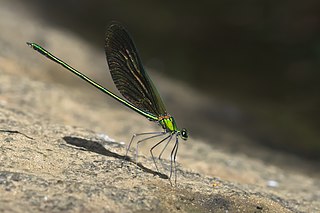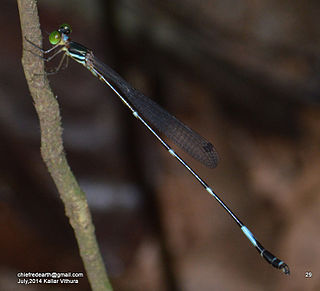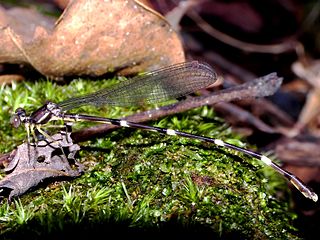
Vestalis apicalis, or the black-tipped forest glory, is a species of damselfly belonging to the family Calopterygidae. It is found in India and Sri Lanka.

Neurobasis chinensis, stream glory is a species of damselfly in the family Calopterygidae. It is a common species distributed across much of Asia.

Indolestes gracilis is a species of damselfly in the family Lestidae. It is known only from Sri Lanka, South India and Cambodia.

Aciagrion hisopa, is a species of damselfly in the family Coenagrionidae. It is abundant in many South Asian countries, but populations in Sri Lanka is still in doubt.

Aciagrion approximans, Indian violet dartlet, is a species of damselfly in the family Coenagrionidae. It is found in east and south of India. The range extends to Thailand, China and Cambodia.

Agriocnemis keralensis, Kerala dartlet, is a species of damselfly in the family Coenagrionidae. It is endemic to Western Ghats in India.

Protosticta gravelyi, the pied reedtail is a damselfly species in the family Platystictidae. It is endemic to Western Ghats in India. It is very widely distributed in hill streams of Western Ghats from Goa to Agasthyamala hills in Thirunelveli district of South India.

Protosticta mortoni, is a damselfly species in the family Platystictidae. It is endemic to Western Ghats in India.

Protosticta hearseyi, the little reedtail, is a damselfly species in the family Platystictidae. It is endemic to Western Ghats in India.
Protosticta antelopoides, the spiny reedtail, is a damselfly species in the family Platystictidae. It is endemic to Western Ghats in India.

Protosticta davenporti, the Anamalai reedtail, is a damselfly species in the family Platystictidae. It is endemic to Western Ghats in India.

Protosticta ponmudiensis, Travancore reedtail, is a damselfly species in the family Platystictidae. It is endemic to southern Western Ghats in India. It is named after the type locality (Ponmudi), a hill station near Thiruvananthapuram, Kerala, where the species was discovered. It was first found by a zoologist and photographer named Sharin.

Protosticta monticola, monticola reedtail, is a damselfly species in the family Platystictidae. It is endemic to southern Western Ghats in India. The species is named monticola considering the natural habitat where the species was discovered.

Protosticta rufostigma is a damselfly species in the family Platystictidae. It is endemic to Western Ghats in India.

Protosticta is a genus of shadowdamsels in the damselfly family Platystictidae. There are more than 50 described species in Protosticta.

Protosticta cyanofemora is a damselfly species in the family Platystictidae. It is endemic to southern Western Ghats in India. The species is named cyanofemora considering its bright blue femur.

Protosticta sholai is a damselfly species in the family Platystictidae. It is endemic to southern Western Ghats in India. The species is named sholai considering the local name of its habitat, montane evergreen forests of South Western Ghats.

Euphaea pseudodispar, the Satara torrent dart, is a species of damselfly in the family Euphaeidae. The species name pseudodispar is coined to remind its close resemblance to Euphaea dispar.

Protosticta armageddonia, the armageddon reedtail, is a damselfly species in the family Platystictidae. It is endemic to Western Ghats in India.

















